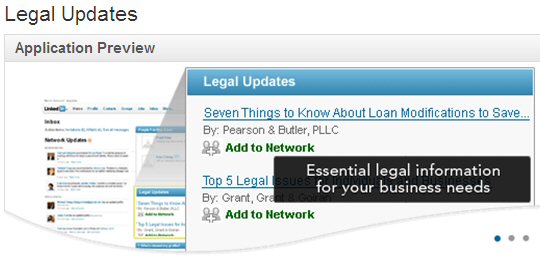A Dozen Social Media Strategies for Lawyers
You can learn how to get new clients and generate new files in a new podcast "Social Media Strategies for Lawyers," a MyLegal.com interview with yours truly. Visit http://bit.ly/aKdtBL and the Blog Talk Radio program will begin to play.
Lisa DiMonte of Washington, DC, the CEO of MyLegal.com, ran the interview. Among the things you'll learn are:
- The huge change from law firm marketing to business development.
- Why an attorney's legal training makes them skeptical of social media.
- The overload of choices in online networking and the solution to dealing with it.
- There is business to be had on online social networking.
- Tips and techniques you can use on LinkedIn today.
- The best lawyer profile I've ever found -- it list clients, industry familiarize and case histories.
- The power of recommendations on LinkedIn - focus on your business leadership, be a person to send referrals to, and identify the clients you want.
- An undocumented "Easter Egg": how to send a message to all of your contacts at once.
- How much time to devote to online social networking.
- Mistakes to avoid in online social networking.
- Three approaches to posting a good message that people will read.
- Using LinkedIn to target potential clients and identify the people you should approach.
It's all at http://bit.ly/aKdtBL. It's 30 minutes, so grab a cup of coffee, lean back and tune in.
 There are a lot of points that corporate general counsel like about their law firms, and they are all pathways to getting more business for their lawyers. They all turn on what retailers call “good customer service.” These behaviors include offering alternative fees, having an effective website, going the extra mile, offering better rates and knowing the client’s business.
There are a lot of points that corporate general counsel like about their law firms, and they are all pathways to getting more business for their lawyers. They all turn on what retailers call “good customer service.” These behaviors include offering alternative fees, having an effective website, going the extra mile, offering better rates and knowing the client’s business. A smart way to generate more business for your law firm is to know what’s going on with your corporate “customers.” Here’s a peek at what’s happening in corporate in-house counsel suites so that you can maximize your business development efforts.
A smart way to generate more business for your law firm is to know what’s going on with your corporate “customers.” Here’s a peek at what’s happening in corporate in-house counsel suites so that you can maximize your business development efforts.
 Not to call in-house lawyers and the people behind Inside Counsel a bunch of introverted party-poopers, but the magazine just published a paranoid report entitled, "
Not to call in-house lawyers and the people behind Inside Counsel a bunch of introverted party-poopers, but the magazine just published a paranoid report entitled, " We already knew that referrals are crucial to a law firm’s business development success. Now comes a survey that specified exactly how important referrals are: referred work typically accounts for 26% of a US law firm’s income.
We already knew that referrals are crucial to a law firm’s business development success. Now comes a survey that specified exactly how important referrals are: referred work typically accounts for 26% of a US law firm’s income. US News & World Report has
US News & World Report has  Legal career consultant
Legal career consultant 


